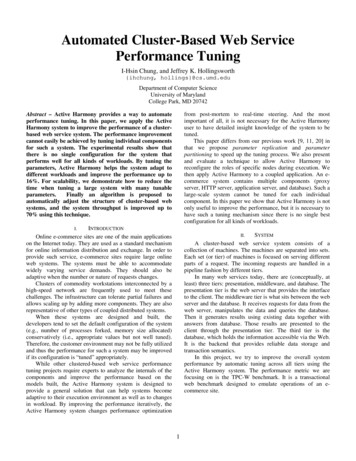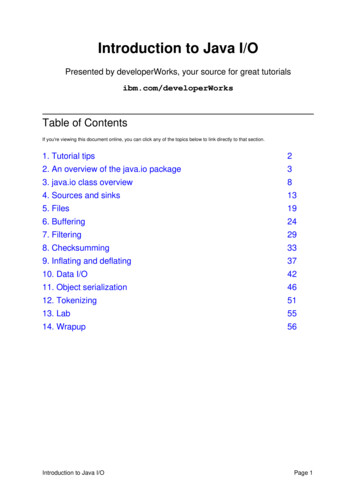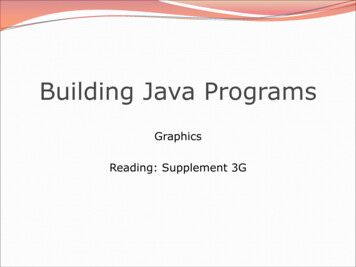
Transcription
Java ApplicationPerformance Tuning forAMD EPYC ProcessorsPublication # 56245 Revision: 0.70Issue Date:January 2018Advanced Micro Devices
2018 Advanced Micro Devices, Inc. Allrights reserved.The information contained herein is for informational purposes only, and is subject to change without notice. Whileevery precaution has been taken in the preparation of this document, it may contain technical inaccuracies, omissionsand typographical errors, and AMD is under no obligation to update or otherwise correct this information. AdvancedMicro Devices, Inc. makes no representations or warranties with respect to the accuracy or completeness of thecontents of this document, and assumes no liability of any kind, including the implied warranties of noninfringement,merchantability or fitness for particular purposes, with respect to the operation or use of AMD hardware, softwareor other products described herein. No license, including implied or arising by estoppel, to any intellectual propertyrights is granted by this document. Terms and limitations applicable to the purchase or use of AMD’s products areas set forth in a signed agreement between the parties or in AMD's Standard Terms and Conditions of Sale.TrademarksAMD, the AMD Arrow logo, AMD EPYC, and combinations thereof, are trademarks of Advanced Micro Devices,Inc. Other product names used in this publication are for identification purposes only and may be trademarks of theirrespective companies.SPECjbb is a registered trademarks and SERT is a trademark of Standard Performance Evaluation Corporation.Linux is a registered trademark of Linus Torvalds.
56245 Rev. 0.70January 2018Java Application Performance Tuning forAMD EPYC ProcessorsContentsOverview . 6GC Tuning . 6Tuning for Exploiting NUMA Architecture . 7Compiler and Kernel Settings . 8Runtime Settings . 9References . 9Appendix AGarbage Collection . 10Appendix BNode Level Binding . 11Initiating Your Java Process by Binding to Nodes. 11Appendix CKernel Parameters . 12Contents3
56245 Rev. 0.70Java Application Performance Tuning forAMD EPYC ProcessorsJanuary 2018List of FiguresFigure 1. AMD EPYC 7601 Processor (2P) showing the groups of SPECjbb 2015 . 84List of Figures
56245 Rev. 0.70January 2018Java Application Performance Tuning forAMD EPYC ProcessorsRevision HistoryDateJanuary 2018Revision0.70DescriptionInitial release.Revision History5
56245 Rev. 0.70Java Application Performance Tuning forAMD EPYC ProcessorsJanuary 2018OverviewJava is a widely accepted language used by programmers for many data-oriented applications,popular for its simple, secure, robust, interpreted, and multithreaded features. From its inception,the language was designed to provide the flexibility for developers to code with featuresincluding architecture neutral, automatic garbage collection, object oriented and inheritance.However performance becomes the key factor once your Java application is ready after testingand debugging. Tuning is required to achieve the expected performance if an application fails toperform well.Garbage collection (GC) tuning, tuning for architectural features like NUMA (non-uniformmemory access), runtime/threads tuning, hotspot compiler, and kernel parameter tuning are someof the important items that may affect Java server performance.Using SPECjbb 2015 as a real world application, this document explains each of these tuningmethods.Sun Hotspot JVM comes with three options:1. Classic ‒ Disables the Hotspot JIT compiler.2. Client ‒ Mainly for client applications. Gives instant performance.3. Server ‒ For server applications, takes time for profiling for HOT methods, then delivers thebest performance.Use option –client or -server according to application deployed as client or server.GC TuningFor a complete description of Java garbage collection basics, orials/obe/java/gc01/index.html. A briefsummary is included here.Allocating the heap as minimum as required helps the application to run smoother. The JVMheap is mainly divided in two generations called young generation (“young gen”) and oldgeneration (“old gen”). For most of the Java server class of applications, 90% of the objects dievery young and can be collected during young gen garbage collection (GC).The young generation can further have an Eden Space and two survivor spaces called From andTo. Survivor spaces contains the tenured objects, once the object reaches certain threshold (againa parameter), it gets transferred to “old” gen.When the Eden space is full, the young gen GC recovers the memory, occurring for a very shortperiod of time, hence the application experiences a short pause that affects performance.6Overview
56245 Rev. 0.70January 2018Java Application Performance Tuning forAMD EPYC ProcessorsAn object surviving for longer periods is kept in old gen. Full GC occurs when the whole heap isfull and has no space for new objects, but experiences a longer pause time to clean the full heapmemory. To avoid longer pauses by full GC, the old gen size should be minimized as low aspossible.GC tuning is typically performed by studying the GC profiles from the application. Theseprofiles are written by the JVM with the specific flags like –Xloggc or –XX: PrintGCDetails.Such profiles help us to understand the behavior of the GC, like amount of memory freed,amount of time spent in doing minor (Eden) and major (full) GCs, amount of heap space wasted(unused), etc. Using such profiles, the developer has to reduce/increase the sizes of the differentpieces of the heaps (like Eden, Survivor space, Old Gen) optimally so that the amount of GCtime spent in the application is less than 1% of the total time spent in the application. Forexample, if the application runs for about an hour, the amount of GC time spent in theapplication (for a healthy application) should not be more than two minutes. This may varydepending on the application. As a case study, we have provided the tuning parameters forSPECjbb 2015 in Appendix A.Tuning for Exploiting NUMA ArchitectureNUMA architecture is prevalent in servers which have many cores and large memory in today’scurrent technology. The AMD EPYC processor also exploits this to get the best performanceout of all cores available (1-128T). However, the application has to be aware of NUMAarchitecture and tune the application accordingly to get the best performance.The AMD EPYC 7601 processor architecture (see Figure 1) has four dies in each socket (1P).Each die has two CCX (Core-complex) units. Each CCX has 4C/8T with its own L1 and L2(512kB). L3 (8MB) cache is shared across cores of a CCX. Since a thread running on one dieruns optimally when it accesses memory from the memory channels connected to the same die, itis best to ensure each Java instance (for example) runs on a single die with memoryallocations/accesses occurring from the channels connected to that die. In fact, we have seen thatif the Java application is run as multiple instances and each Java instance is bound at the die orthe CCX level and bind the memory to the local memories (connected to the local channels), theperformance on the AMD EPYC processor peaks.Using the AMD EPYC 7601 processor architecture (64C/128T, 512GB) as an example, havingone Java instance per CCX (4C/8T, 32 GB)/total 16 JVMs improves performance on the overallsystem. Hence, binding the JVM process to CCX (4C/8T, 32GB) or Node (2CCX-8C/16T,64GB) can provide the best performance.The following figure shows how the SPECjbb 2015 Multi JVM instance is run on each CCX onthe AMD EPYC 7601 processor. In the figure, G1, G2 etc refers to the group of the SPECjbb2015. When we run in this configuration, we also make sure we bind the memory of each groupto the local memory.Tuning for Exploiting NUMA Architecture7
Java Application Performance Tuning forAMD EPYC Processors56245 Rev. 0.70January 2018Figure 1. AMD EPYC 7601 Processor (2P) showing the groups of SPECjbb 2015You can see more details of our experience with SPECjbb 2015 in Appendix B.Compiler and Kernel SettingsThe HotSpot JVM contains two JIT-compilers, namely the C1 (client) compiler and the C2(server) compiler. C1 and C2 runs within the context of the application (along with theapplication) and compiles the “hot” methods of the application at various compilation levels. C1compiles the interpreted methods (after some threshold of “hotness”) at the optimization levels,1, 2, and 3, while C2 compiles the methods at the highest level of optimization of level 4. Level1 is simple optimization, Level 2 is with minimal profiles, Level 3 collects at full profile andLevel 4 performs full optimization using the full profiles (collected at Level 3). This is called“tiered” compilation and research has shown that this helps optimize the runtime of theapplication significantly.There are many compiler flags which may be useful for tuning the Java server application. Forexample, we can compile any method at any levels using the options given. We can also excludecompiling methods if there are issues in compiling those methods. We can also change theamount of inlining, loop optimization, etc., as applied by the compiler using different JVM flags.In general, it is not recommended to change the flow of the compiler (since Hotspot does a goodjob of compilation), however if we find any opportunities/reasons to give specific hints to thecompiler, we should tune the application using the flags provided. For example, for SPECjbb 2015, we found that inlining a few methods (big methods) at early stage improves theperformance of AMD EPYC processors.8Compiler and Kernel Settings
56245 Rev. 0.70January 2018Java Application Performance Tuning forAMD EPYC ProcessorsThere are several kernel parameters which are known to work well with Java applications. Forexample, if the Java application runs large number of threads, it may be useful to avoid too manycontext switches. The Appendix C gives our experience with such parameters with SPECjbb2015.Runtime SettingsOne of the tuning factors affecting performance can be number of threads the application runs. Ifthe number of threads the application creates is much more than the hardware threads available,then such an environment may need tuning. Also, there may be different types of threads:producer, consumer, network threads, etc. Depending on how loaded they are, and howperformance critical they are, it may be best to tune the number of such threads to get optimalperformance from the system. The current Linux kernels provide all such parameters for tuning.For SPECjbb 2015, we performed the following tuning for number of threads and otherparameters. A few of them are shown below:1) Selector Runner Threads: These threads are spawned for servicing the network activity fromthe application. For max-JOPS (one of the scores in SPECjbb 2015) we set the value as 1 or2. This number creates the multiple of 6 worker thread for controller, multiple of 5 for BE,and multiple of 5 for TxI. Setting it to a large number severely affects performance of maxjops.2) Map-Reducer Pool size: These threads perform the job of report generation by map reducingthe work with the help of fork join worker thread. Optimal value is 5 for max-JOPS.Decreasing to lower values affects the performance.3) Fork-join Worker Threads: These are worker threads in the backend instance which servicethe requests coming from simulated workload. This works in multiple tiers. These are set inthree tiers, found Tier1 170 Tier2 48 and Tier3 28 to be optimal.Client pool size is for the number of socket connection to be opened for each agent. The workerpool threads binds to each socket and keeps on waiting for the responses from fork join workerTier1 threads. If the Tier1 threads are not able to respond quickly, the performance is affected.So the problem cannot be resolved by decreasing or increasing the Tier1 threads, optimal numberof threads are required. For increasing the Tier1 threads, the heap also required to increase soperformance goes down by increasing the memory to more than 31G, as it requires more CPUtime to free up the /06/06/linux-scheduler-cfs-and-latency/Runtime Settings9
56245 Rev. 0.70Java Application Performance Tuning forAMD EPYC ProcessorsJanuary 2018Appendix A Garbage CollectionAnalysisJava application performance can be analyzed with GC logs. For analysis any online gcanalyzing tool can be used. If the application throughput is as per the expectation, we do notneed to tune else few GC flag values are required to change. For SPECjbb 2015, we tune basedon GC logs. The logs can be collected by running the application along with the following flags-XX: PrintGC -XX: PrintGCDetails -XX: PrintGCTimeStamps -XX: PrintHeapAtGC XX: PrintTenuringDistribution(Options are available in JAVA 8)TuningHeap setting flags -Xmx -Xms –Xmn (Maximum heap, Minimum heap, Young gen heaprespectively) should be set according to the requirement. For example for SPECjbb 2015 we thevalues as –Xmx28g –Xms28g –Xmn26g( “g” is for GB).GC threads are important to set. For e.g. 1Node (Die) – 8C/16T we set the value 16 as theoptimal value for GC thread is equal to or slightly higher to the number of available core.Increasing to large value degrades the performance.Survivor Ratio decides the size of Eden and two survivor spaces so for the value of28(SurvivorRatio) the size of survivor spaces calculated asOne Survivor Space -Xmn / (28 2).Max Tenuring Threshold decides the age of object survival in young gen. For example, if anobject has this count as 15 then after next young gen GC, the object will move to the old gen. Soit remains in the young gen survivor spaces till it reaches to this threshold. Optimal value forsurvivor threshold for SPECjbb 2015 seem to be 15.The flags we use for SPECjbb 2015:-XX: UseParallelOldGC -XX:SurvivorRatio 28 -XX:TargetSurvivorRatio 95 XX:ParallelGCThreads 16 -XX:MaxTenuringThreshold 15Among different available GC’s (Parallel, CMS and G1GC) the best for SPECjbb 2015 isParallelOldGC. The other GCs do not work well for SPECjbb 2015 since their purposes aredifferent. Garbage collector also should be chosen based on the type of application.(For further details refer to: options-jsp140102.html)10Garbage Collection
56245 Rev. 0.70January 2018Appendix BJava Application Performance Tuning forAMD EPYC ProcessorsNode Level BindingAs explained in the earlier sections, in cases where the application can be split into multiple Javainstances, binding each Java process at Node level or CCX level (along with binding the memorychannels to those dies/CCX) gives significant performance boost. For example for SPECjbb 2015, we bind the processes at CCX Level or Node (die) Level.For NUMA binding, we use the command called “numactl” on Linux as:Core level/CCX level binding:numactl –physcpubind 0,1,2,3,4,5,6,7 –membind 0 JAVA Process Node Level binding:numactl –cpunodebind 0 –membind 0 JAVA Process GCThreads should be changed according to the binding. For example if binding to a specificnode then threads should be equal to no of cores in that node. Similarly, for any other parameterwhich depends on no of available processor, should be changed according to the binding.Memory should not be allocated more than the available on particular node.(Use numactl –H command to check the available memory on particular node)Initiating Your Java Process by Binding to NodesThe numactl -H command gives the NUMA node structure of the system (for more information,see https://linux.die.net/man/8/numactl).1) --cpunodebind: This option binds to the particular node.2) --physcpubind: This binds to physical core. So use this if the binding is according to cores.Check the core numbering before binding.3) --interleave all: This option sets the memory to be used across all NUMA nodes, so theallocation will be done on different nodes the system finds optimal to allocate.4) –membind 0: This option binds the memory to particular node. So binding the process tospecific node where the memory allocation is restricted to happen on that node.5) –localalloc: To allocate the memory locally according to the cpunodebind.Initiating Your Java Process by Binding to Nodes11
56245 Rev. 0.70Java Application Performance Tuning forAMD EPYC ProcessorsJanuary 2018Appendix C Kernel ParametersAs explained in the earlier section, a few kernel parameters (which affect the thread scheduling,page swapping, etc.) are useful for some Java server processes running for longer time.Scheduler Tunable:On Linux systems CFS scheduler comes with different parameter which can be tunedaccording to the type of application. Few parameters we change for SPECjbb 2015 are:a) sched migration cost ns: It determines how long a migrated process has to be runningbefore the kernel will consider migrating it again to another core. Default value 50000(that's ns so 0.5 ms), we reduce it to 1000 to have high migration.b) sched rt runtime us: A global limit on how much time real-time scheduling may use.We increase the value to 990000, so this gives 0.01s out of total period of 1s to be usedby other non-RT tasks.c) sched latency ns: Period over which CFQ tries to fairly schedule the tasks on the runqueue. All of the tasks on the run queue are guaranteed to be scheduled once within thisperiod. By default, this is set to 20ms. For SPECjbb 2015 we set it to 24ms.d) sched min granularity ns: This decides the minimum time a task will be allowed torun on CPU before being pre-empted out. By default, it is set to 4ms. So by default, anytask will run at least 4ms before getting pre-empted out. We found the optimal value forSPECjbb 2015 is 10ms.Other Tunable:a) dirty background ratio: Contains, as a percentage of total available memory thatcontains free pages and reclaimable pages, the number of pages at which the backgroundkernel flusher threads will start writing out dirty data. For SPECjbb 2015 we set it to 10.b) dirty ratio: Contains, as a percentage of total available memory that contains free pagesand reclaimable pages, the number of pages at which a process which is generating diskwrites will itself start writing out dirty data. For SPECjbb2015 we set it to 40.c) dirty writeback centisecs: The pdflush writeback daemons will periodically wake upand write "old" data out to disk. This tunable expresses the interval between thosewakeups, in 100’Th of a second. Setting this to zero disables periodic write backaltogether. For SPECjbb2015 we set it to 1500.d) dirty expire centisecs: This tunable is used to define when dirty data is old enough tobe eligible for writeout by the pdflush daemons. It is expressed in 100’Th of a second.Data which has been dirty in memory for longer than this interval will be written out nexttime when a pdflush daemon wakes up. For SPECjbb 2015 we set it to 10000e) swappiness: Sets the kernel's balance between reclaiming pages from the page cache andswapping process memory. The default value is 60.For SPECjbb 2015 we set it to 10.These kernel parameter setting comes from some level of experimentation and knowledge ofLinux kernel.12Kernel Parameters
An object surviving for longer periods is kept in old gen. Full GC occurs when the whole heap is full and has no space for new objects, but experiences a longer pause time to clean the full heap memory. To avoid longer pauses by full GC, the old gen size should be minimized as low as possible.











